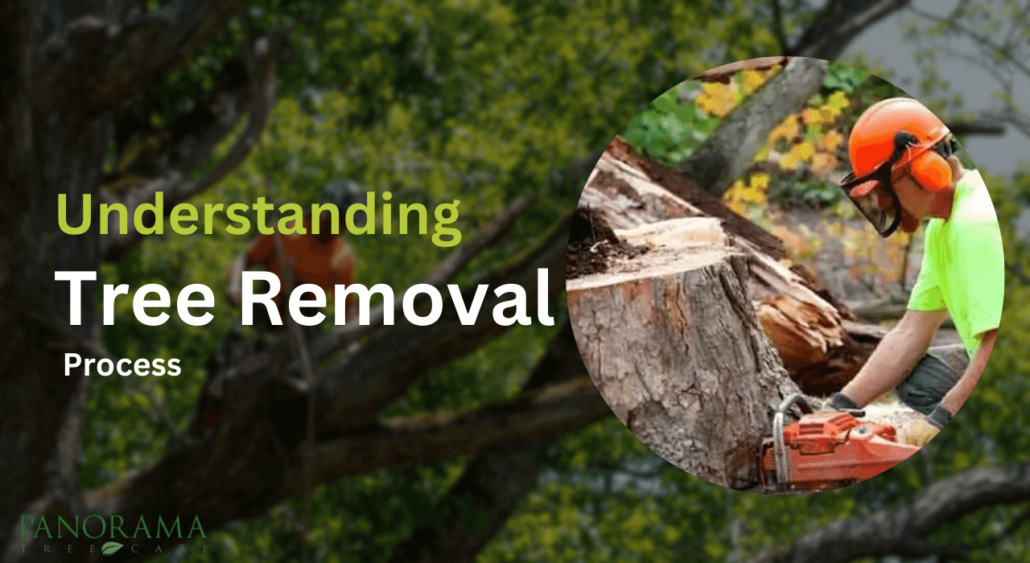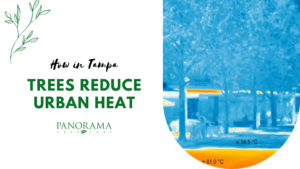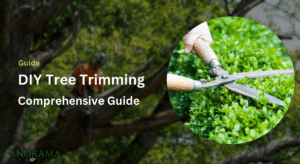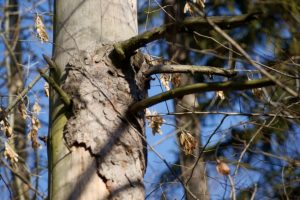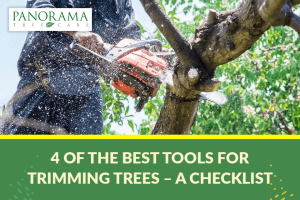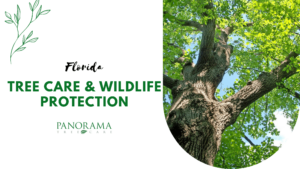When we talk about keeping our surroundings safe and beautiful, sometimes we have to make the tough decision to remove a tree.
It’s not just about cutting down trees; it’s about making informed choices for the safety and aesthetic of our properties.
Let’s dive into why and how tree removal can be necessary and why it’s crucial to involve professionals like Panorama Tree Care in the process.
Definition of Tree Removal
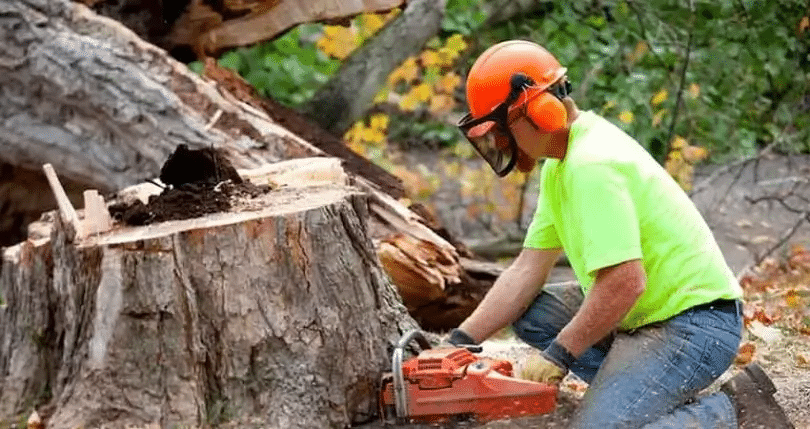
Tree removal involves cutting down a tree, usually because it’s dead, diseased, or poses a risk to property and people.
It’s a detailed process that requires careful planning and execution to ensure it’s done safely and efficiently.
Why Tree Removal is Sometimes Necessary
Trees are vital to our environment, but there are times when removing them is the best option. Safety is a top concern; a damaged or diseased tree can fall, causing harm to people and buildings.
Property protection is another reason. Trees with expansive root systems can damage foundations, sidewalks, and driveways.
Also, trees suffering from disease or pest infestations can pose a risk to other healthy trees around them.
Assessing the Need for Tree Removal
Assessing the need for tree removal is a crucial step in maintaining the safety and aesthetic of your property. It involves a careful evaluation of the tree’s health, its impact on the surroundings, and whether it poses any risks.
Signs That a Tree May Need to Be Removed
- Structural Damage: Trees that have sustained significant damage, either through environmental conditions like storms or due to age-related decay, might have compromised structural integrity. This includes large, dead branches in the canopy, cracks in the trunk, or a lean that indicates weak roots.
- Disease: Signs of disease can range from discolored leaves and reduced foliage to visible pests and fungi. Diseases not only affect the health of the tree but can also spread to nearby vegetation, posing a broader risk to the landscape.
- Safety Hazards: A tree might become a safety hazard due to its location. For instance, trees that are too close to buildings, power lines, or walkways can pose a threat if there’s a risk of branches falling.
Evaluating the Tree’s Location and Potential Risks
The location of a tree is a significant factor in determining whether it needs to be removed.
Trees that interfere with infrastructure, obstruct sightlines for traffic, or are too close to buildings must be assessed carefully.
The potential risks involve not just the immediate danger of falling branches or the tree itself but also the long-term implications like root growth affecting foundations or utility lines.
Consulting with Certified Arborists
This is where the expertise of certified arborists comes into play. Arborists from Panorama Tree Care, for example, are trained to evaluate the health and structural integrity of trees.
We can determine whether a tree can be saved through treatment or pruning or if removal is the best course of action.
Certified arborists conduct a thorough inspection, considering the tree’s species, age, growth patterns, and any signs of distress.
We also evaluate the tree’s impact on its environment, including potential risks to property and people.
Their assessment is crucial in making an informed decision that balances safety, health, and aesthetics.
Working with tree removal experts near Tampa ensures your tree is evaluated thoroughly and removed with the highest level of care, minimizing risk to your property and the environment.
Planning and Preparation
The planning and preparation phase is a vital step in the tree removal process that ensures the job is done safely, legally, and with minimal disruption to the surrounding area.
Obtaining Necessary Permits and Approvals
Before a tree can be removed, it’s important to check with local authorities regarding any permits or approvals that may be required.
This step is crucial because regulations concerning tree removal can vary significantly from one area to another.
Some regions might protect certain tree species, or have specific regulations based on the tree’s size, location, and reason for removal.
Professional tree removal experts like us, are familiar with these regulations and can navigate the permit process efficiently, ensuring that all legal requirements are met before proceeding.
Ensuring Safety Precautions
Safety is paramount in tree removal, not just for the workers involved but also for residents, pedestrians, and nearby properties. Key safety precautions include:
- Utility Line Clearance: Trees close to power lines pose a significant risk. Professionals will coordinate with utility companies to ensure lines are de-energized, shielded, or carefully avoided during the removal process.
- Property Protection: Measures are taken to protect the property and its surroundings. This might involve setting up barriers to prevent falling debris from damaging buildings, vehicles, or landscaping.
- Personal Protective Equipment (PPE): Every individual involved in the tree removal process must wear appropriate PPE, including helmets, gloves, eye protection, and fall arrest systems when working at heights.
Scheduling and Logistics
Coordinating the timing and logistics of a tree removal project is essential to minimize inconvenience to property owners and the public. This involves:
- Choosing the Right Time: The timing of the removal can depend on various factors, including the tree’s condition, weather conditions, and local regulations. For instance, removing a tree in active decay or after a storm may be urgent, while other cases might allow for more flexibility.
- Access and Equipment: Planning the access route for heavy equipment, such as cranes or stump grinders, is essential, especially in tight spaces. Professionals will evaluate the best approach to reach the tree safely and efficiently.
- Communication with Property Owners: Keeping property owners informed about the schedule, what to expect, and any necessary preparations on their part (like moving vehicles or securing pets) ensures the process goes smoothly.
The Tree Removal Process
The tree removal process is a detailed and complex operation that requires expertise, precision, and safety measures.
This process is meticulously planned and executed by professionals to ensure that the tree is removed without causing harm to people, property, and the surrounding environment.
Step-by-Step Guide to the Removal Process
- Initial Assessment and Planning: The first step involves a thorough assessment of the tree and its surroundings. This includes determining the tree’s size, health, and position relative to structures, utility lines, and other trees. Based on this assessment, professionals develop a strategy that dictates the direction of the fall, the equipment needed, and the number of personnel involved.
- Setting up the Work Area: Before the actual removal begins, the work area is secured to ensure the safety of both the crew and any bystanders. This might involve cordoning off the area, placing signs, and ensuring that there is a clear path for the removal of debris.
- Climbing and Positioning: In many cases, especially with large or hazardously positioned trees, arborists will climb the tree to remove it in sections. They use harnesses, ropes, and safety gear to ascend safely and position themselves to start the cutting process.
- Rigging: Rigging involves setting up ropes and pulleys that will be used to control the descent of cut sections of the tree. This is crucial for preventing damage to property and ensuring the safety of the crew and bystanders. The rigging process is tailored to each specific situation, depending on the tree’s size and the proximity to obstacles.
- Cutting and Sectional Removal: The actual cutting begins with the arborist making precise cuts to remove branches and sections of the trunk. These sections are either dropped safely to the ground in a controlled manner using the rigging system or directly cut and guided down by other team members. For larger trees, this process is done in stages, starting from the top and working down to minimize the risk of uncontrolled falls.
- Crane Operations: In situations where trees are too large, too decayed, or too dangerously positioned for climbing and rigging alone, cranes may be employed. Cranes can safely lift large sections of the tree over obstacles and lower them to a designated drop zone. This method requires significant expertise and coordination among the crew.
- Final Cut and Tree Felling: If the tree is being removed in one piece, or when it comes to removing the final section of the trunk, the final cut is planned to guide the tree’s fall in the predetermined direction. This step is meticulously calculated to ensure that the tree lands safely within the designated area.
Safety Measures Taken During Removal
Safety is the overarching concern throughout the tree removal process. This includes:
- Personal Protective Equipment (PPE): All crew members wear PPE, such as helmets, gloves, eye protection, and ear protection, to guard against injury.
- Communication: Continuous communication is maintained among the team members during the operation. Hand signals, radios, or other communication tools are used to coordinate actions, especially when noise levels are high or visibility is limited.
- Emergency Preparedness: Professional tree removal teams are trained to handle emergencies. This includes having first aid kits, emergency plans, and the ability to quickly evacuate the area if needed.
At Panorama Tree Care, our tree removal process experts Tampa handle every phase with precision—from initial assessment to final cleanup—ensuring safety, efficiency, and professionalism throughout.
Stump Removal and Grinding
Once the tree has been successfully removed, the question of what to do with the remaining stump arises. Panorama Tree Care offers several options, each with its own advantages.
Stump grinding is a popular choice, as it involves using specialized machinery to grind the stump down to a certain depth, leaving behind a layer of wood chips that can be easily removed or incorporated into the soil. This method is effective in reclaiming valuable space and preventing potential trip hazards.
Alternatively, chemical treatments can be applied to the stump, accelerating the natural decomposition process.
For those seeking a more immediate solution, manual stump removal is also an option, though it can be labor-intensive and may require additional equipment.
Whichever method you choose, Panorama Tree Care’s experienced team will guide you through the process and ensure that the stump removal is carried out safely and efficiently.
Cleanup and Disposal
After the tree has been removed and the stump addressed, the final step is the cleanup and disposal of the remaining debris.
We understand the importance of responsible waste management and follows strict protocols to ensure that all tree limbs, branches, and other materials are properly disposed of or repurposed.
Our commitment to sustainability extends to exploring recycling and repurposing options for the removed trees.
Whether it’s mulching the wood chips for landscaping purposes or donating usable lumber to local organizations, Panorama Tree Care strives to minimize waste and maximize the value of the removed trees.
Replanting and Landscaping
For many homeowners and property managers, the removal of a tree can leave a noticeable void in the landscape.
Panorama Tree Care recognizes this and offers comprehensive landscaping and replanting services to help restore the beauty and balance of your outdoor spaces.
Their team of knowledgeable horticulturists and landscape designers will work closely with you to assess the site conditions, soil composition, and your aesthetic preferences.
We’ll provide expert guidance on selecting suitable replacement trees or shrubs that will thrive in the given environment and complement the overall landscape design.
Additionally, we can assist with the installation and maintenance of these new plantings, ensuring they receive the proper care and attention needed to establish strong roots and flourish for years to come.
Hiring Panorama Tree Care
By now, it should be evident that tree removal is a complex process that requires specialized knowledge and expertise.
That’s why hiring a reputable and experienced tree care company like us is an investment worth making.
With a team of certified arborists, state-of-the-art equipment, and a commitment to safety and sustainability, Panorama Tree Care is well-equipped to handle even the most challenging tree removal projects.
Our reputation for excellence is backed by glowing customer testimonials and a track record of successful projects.
Moreover, We prioritizes open communication and transparency, ensuring that you are kept informed and involved throughout the entire process.
Our dedication to customer satisfaction is unparalleled, making them the ideal choice for all your tree care needs.
Conclusion
Tree removal is more than just clearing space—it’s about making thoughtful, informed decisions that protect your property, enhance your landscape, and support long-term environmental health. With Panorama Tree Care, you get expert guidance every step of the way—from assessment and removal to stump grinding and replanting.
Let us help you navigate the process with safety, efficiency, and care.
Contact us today to schedule a consultation and take the first step toward a safer, healthier, and more beautiful property.

